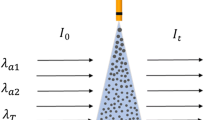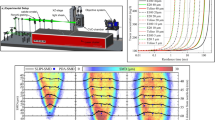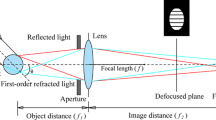Abstract
The cyclic variations of vapor distributions of a binary-component fuel spray were experimentally investigated. Ultraviolet–visible laser absorption/scattering technique was adopted for quantitative measurement of vapor mass distributions in a binary-component fuel spray. n-Hexane and p-xylene were chosen to form the binary-component test fuel. Intersection-over-union, an important concept in object detection, was firstly introduced to characterize more precisely the spray cyclic variations, in comparison with other traditional methods including presence probability image and coefficient of variation in spray penetration. As a result, a larger fluctuation was observed in vapor distributions of the higher boiling point component (p-xylene) in the binary-component fuel compared to that of the pure p-xylene spray, indicating that evaporation characteristic of multi-component fuel spray is one of the significant factors that affects the cyclic variations. Based on large amount of experimental observations, a concept of spray vapor distribution area with consideration of cyclic variation was proposed to give a more reasonable expression of spray structure, and a new empirical formula of spray vapor distribution area was given for prediction and numerical model validation.
Graphic abstract














Similar content being viewed by others
References
Chen H, Hung DLS, Xu M, Zhong J (2013) Analyzing the cycle-to-cycle variations of pulsing spray characteristics by means of the proper orthogonal decomposition. At Sprays 23:623–641
Chen R, Nishida K, Shi B (2019) Quantitative investigation on the spray mixture formation for ethanol-gasoline blends via UV–Vis dual-wavelength laser absorption scattering (LAS) technique. Fuel 242:425–437
Fansler TD, Parrish SE (2015) Spray measurement technology: a review. Meas Sci Technol 26(1):012002
Fujikawa T, Nomura Y, Hattori Y, Kobayashi T, Kanda M (2003) Analysis of cycle-by-cycle variation in a direct injection gasoline engine using a laser-induced fluorescence technique. Int J Engine Res 4:143–153
Gitlin JM (2018) Compression ignition engines are a big breakthrough—we got to try one. Ars Technica Web. https://arstechnica.com/cars/2018/01/mazdas-skyactiv-x-shows-the-internal-combustion-engine-has-a-future/
Goryntsev D, Sadiki A, Klein M, Janicka J (2009) Large eddy simulation-based analysis of the effects of cycle-to-cycle variations on air-fuel mixing in realistic DISI IC-engines. Proc Combust Ins 32(2):2759–2766
Goryntsev D, Sadiki A, Janicka J (2012) Cycle-to-cycle variations based unsteady effects on spray combustion in internal combustion engines by using LES. SAE tech paper 2012-01-0399
Hiroyasu H, Arai M (1990) Structures of fuel sprays in diesel engines. SAE tech paper 1050-1061
Hung DLS, Chmiel DM, Markle LE (2003) Application of an imaging-based diagnostic technique to quantify the fuel spray variations in a direct-injection spark-ignition engine. SAE tech paper 2003-01-0062
Hung DLS, Harrington DL, Gandhi AH et al (2008) Gasoline fuel injector spray measurement and characterization—a new SAE J2715 recommended practice. SAE Int J Fuels Lubr 1(1):534–548
Itani LM, Bruneaux G, Di Lella A, Schulz C (2015) Two-tracer LIF imaging of preferential evaporation of multi-component gasoline fuel sprays under engine conditions. Proc Combust Inst 35:2915–2922
Marchi A, Nouri J, Yan Y, Arcoumanis C (2010) Spray stability of outwards opening pintle injectors for stratified direct injection spark ignition engine operation. Int J Engine Res 11:413–437
Meijer M, Somers B, Johnson J, Naber J, Lee SY, Malbec LMC, Bruneaux G, Pickett LM, Bardi M, Payri R, Bazyn T (2012) Engine combustion network (ECN): characterization and comparison of boundary conditions for different combustion vessels. Atom Sprays 22(9):777–806
Naber JD, Siebers DL (1996) Effects of gas density and vaporization on penetration and dispersion of diesel sprays. SAE Trans 105:82–111
Otsu N (1979) A threshold selection method from gray-level histograms. IEEE Trans Syst Man Cybern 9(1):62–66
Pastor JV, García-Oliver JM, López JJ, Micó C (2016) Application of UV–visible light absorption and scattering technique to low absorption fuels under diesel-like conditions. Fuel 179:258–266
Payri R, Ruiz S, Salvador FJ, Gimeno J (2007) On the dependence of spray momentum flux in spray penetration: momentum flux packets penetration model. J Mech Sci Technol 21:1100–1111
Qi W, Zhang Y (2018) A three-color absorption/scattering imaging technique for simultaneous measurements on distributions of temperature and fuel concentration in a spray. Exp Fluids 59(4):70
Qi W, Zhang Y (2019) Quantitative measurement of binary-component fuel vapor distributions via laser absorption and scattering imaging. Appl Phys B 125(7):127
Qin W, Hung DLS, Xu M (2015) Investigation of the temporal evolution and spatial variation of in-cylinder engine fuel spray characteristics. Energy Convers Manag 98:430–439
Schulz C, Gronki J, Andersson S (2004) Measurements in a diesel spray. SAE tech paper 1032-1042
Senda J, Kanda T, Kobayashi M, Fujimoto H (1997) Quantitative analysis of fuel vapor concentration in diesel spray by exciplex fluorescence method. SAE tech paper 1012-1024
Vermorel O, Richard S, Colin O, Angelberger C, Benkenida A, Veynante D (2009) Towards the understanding of cyclic variability in a spark ignited engine using multi-cycle LES. Combust Flame 156:1525–1541
Westlye FR, Penney K, Ivarsson A, Pickett LM, Manin J, Skeen SA (2017) Diffuse back-illumination setup for high temporally resolved extinction imaging. Appl Opt 56:5028–5038
Wieske P, Wissel S, Grünefeld G, Graf M, Pischinger S (2006) Experimental investigation of the origin of cyclic fluctuations in a DISI engine by means of advanced laser induced exciplex fluorescence measurements. SAE tech paper 2006-01-3378
Wu S, Xu M, Hung DL, Li T, Pan H (2016) Analyzing the cycle-to-cycle variations of vapor and liquid phases of evaporating SIDI sprays via proper orthogonal decomposition technique. SAE Int J Engines 9(1):193–200
Yoon JK, Myong KJ, Senda J, Fujimoto H (2009) Analysis of spatial vapor-phase distribution using the LIF method on multi-component fuel. J Mech Sci Technol 23:2565–2573
Zhang Y (2001) A study on mixture formation in diesel sprays with split injection strategy. Dissertation, Hiroshima University
Zhang Y, Nishida K (2007) Vapor distribution measurement of higher and lower volatile components in an evaporating fuel spray via laser absorption scattering (LAS) technique. Combust Sci Technol 179:863–881
Zhang R, Sick V (2007) Multi-component fuel imaging in a spray-guided spark-ignition direct-injection engine. SAE tech paper 2007-01-1826
Zhang Y, Yoshizaki T, Nishida K (2000) Imaging of droplets and vapor distributions in a Diesel fuel spray by means of a laser absorption–scattering technique. Appl Opt 39:6221–6229
Zhang Y, Li S, Qi W, Nishida K (2017) Evaporation characterization of fuel spray impinging on a flat wall by laser-based measurement. Int J Engine Res 18:776–784
Zhou X, Li T, Lai Z, Wei Y (2019) Modeling diesel spray tip and tail penetrations after end-of-injection. Fuel 237:442–456
Zigan L, Schmitz I, Flügel A, Wensing M, Leipertz A (2011) Structure of evaporating single- and multicomponent fuel sprays for 2nd generation gasoline direct injection. Fuel 90:348–363
Zigan L, Shi JM, Krotow I, Schmitz I, Wensing M, Leipertz A (2013) Fuel property and fuel temperature effects on internal nozzle flow, atomization and cyclic spray fluctuations of a direct injection spark ignition-injector. Int J Engine Res 14:543–556
Acknowledgements
The research was sponsored by National Natural Science Foundation of China (No. 91741130) and Intergovernmental International Cooperation in Science and Technology Innovation (No. 2016YFE0127500).
Author information
Authors and Affiliations
Corresponding author
Additional information
Publisher’s Note
Springer Nature remains neutral with regard to jurisdictional claims in published maps and institutional affiliations.
Rights and permissions
About this article
Cite this article
Qi, W., Zhou, Y. & Zhang, Y. Laser-based measurements and analyses on cycle-to-cycle variations of mixture formation in binary-component fuel sprays. Exp Fluids 61, 87 (2020). https://doi.org/10.1007/s00348-020-2925-9
Received:
Revised:
Accepted:
Published:
DOI: https://doi.org/10.1007/s00348-020-2925-9




